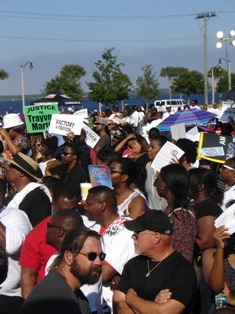|
Sanford Shooting Sparks Conversation about Public Spaces  Fort Mellon Park rally Since Sanford was founded in the late 1870s the city has benefited from a network of parks and a scenic lake front. Now protesters are filling those spaces in support of Trayvon Martin, the unarmed black teenager shot while walking in a gated community. Recent events are sparking a conversation about the division between public and private space in the city. Planners view Sanford’s network of parks and walkable streets as an inspiration for back-to-basics urban renewal. Since 1995, more than 20 million dollars has been poured into upgrading the city’s green spaces, and it’s something visitors notice- even the reverend Al Sharpton. “Sanford is a beautiful city. It’s on the side of the water, has great potential for tourism," he said at a recent rally. When it was founded in the 1870s, Sanford was an important destination for steamships. Since then Orlando has become the main commercial hub for Central Florida, but transportation is once again playing a role in Sanford's growth. The city serves as an interchange for I-4 and the 417 and boasts a busy international airport. Sanford’s economic development officer Nicholas Mcray says the arrival of the SunRail commuter train will also give the city a lift. “Redevelopment and development opportunities around Sanford SunRail station, for transit oriented type development, I guess you could say the sky’s the limit," says Mcray. "There’s a lot of green space still left around there so the right type of growth can occur there, to make connections to our community, to our activity centers.” The well maintained downtown is front and center because of recent demonstrations.
Bruce Stephenson, the director of the Masters of Planning and Civic Urbanism program at Rollins College is following the protests closely. He contrasts the peaceful demonstrations with the violent act that got them started. “The shooting was in a private space that was gated, guarded, and I think there’s a lesson to be drawn in what happens when we shut ourselves off from other citizens.” There are others who agree the division of private and public space could have a part to play in this case. Paul Harris, the chair of the psychology department at Rollins College, is an expert in the links between physical settings and human response. He says in some neighborhoods, residents don’t always see their territory ending at their front door. “They see it extending out into the yard, the street. And in that case you’re going to have people more zealously protecting those spaces.” There may be other lessons to learn from the Martin case. Bruce Stephenson says Sanford has the right idea in trying to craft a downtown where people from all backgrounds can mingle. He says the revamped Riverwalk park along Lake Monroe is a crowning success. “What’s important about that space is that it’s connected and linear, it runs along the water," says Stephenson. "Its whole concept is to move people and connect people. Those are the steps in creating community, and Sanford has made tremendous leaps, but there is an historical legacy to overcome.” Stephenson says the city would do well to redouble its efforts in revitalizing its streets and parks.
Nicholas Mcray says Sanford’s quality of life is the envy of many other communities, and he thinks that will shine through when the cameras leave. “We’re very proud of our community, of the assets it has, of its citizenry. We live up to our moniker, Sanford the friendly city.” Once the crowds go home, Sanford does plan to continue its improvement program. A 7 million dollar extension of the popular Riverwalk promenade could begin construction as early as fall. |
|
|